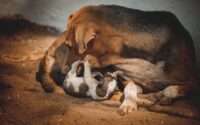Why Does My Dog Circle Me? The Secret Canine Language Revealed
Dogs have always been our loyal companions, filling our lives with boundless joy and unwavering love. Yet, amidst all their endearing antics, one behavior tends to captivate our attention and curiosity – the act of circling. “Why does my dog circle me?” It’s a question that has tugged at the heartstrings of dog owners across the world.
In this comprehensive guide, we will explore the fascinating world of canine circles, shedding light on the various reasons why your dog might be twirling around you like a four-legged dancer. From ancient instincts to modern communication, this article will unveil the secrets behind your pup’s mesmerizing spins.
The Canine Instinct: A Brief Overview of Circles
Dogs, our loyal companions, have a rich history rooted in the wild. It’s essential to delve into their ancestral instincts to understand why they engage in the mesmerizing art of circling. Just like their wolf ancestors, dogs have a strong connection to their environment, and this includes their tendency to circle.
Circling is not a behavior exclusive to the dog-human relationship. Puppies, from an early age, engage in playful circling antics. This serves as a vital part of their development, helping them fine-tune their motor skills, coordination, and spatial awareness. In essence, it’s a canine ballet of sorts, allowing them to gain a deeper understanding of their world.
Circling behaviors come in various forms, each with its own unique story to tell. From the ritualistic pre-potty circle to the ecstatic zoomies in the yard, our four-legged friends have a mesmerizing repertoire of circle dances they perform for different occasions. Understanding these circles can offer valuable insights into their emotions and needs.
Communication Through Circles
You’ll be amazed at how much our dogs communicate through their body language, and circling is no exception to this expressive symphony. When your dog circles around you, they’re conveying a lot more than meets the eye.
In the intricate dance of canine body language, circling is like a whispered secret. It’s a gentle, non-verbal nudge that tells you, “Hey, I’m here, and I trust you.” When your dog circles around you, they’re inviting you into their world, a world where trust and camaraderie reign supreme. It’s a sign of their affection and their way of saying, “You’re an important part of my pack.”
Circling can also be a signal. Your dog might be trying to communicate something specific, such as the desire to go outside or to play. Pay close attention to their behavior during the circle. Is their tail wagging with excitement, or are they looking expectantly at the door? Understanding the context of the circle can help you decode their message.
The Scent Trail Hypothesis
Now, let’s talk about a fascinating aspect of circling that’s deeply rooted in your dog’s primal instincts—scent. Dogs live in a world rich with odors, and they have a keen sense of smell. This olfactory world is where the magic of the scent trail hypothesis comes into play.
Your dog’s circling isn’t just a random spin; it’s a calculated endeavor to leave their mark. In the wild, this behavior served as a way for canines to establish territory and communicate with their fellow pack members. By creating a scent trail, they marked their presence and communicated valuable information to others.
So, when your dog circles around you, they’re essentially creating a scent trail that says, “I’ve been here.” While it may not be as primal in our living rooms, the instinct remains. Your dog is marking you as a cherished part of their territory. It’s a beautiful testament to the bond you share.
Understanding the scent trail hypothesis gives you a glimpse into your dog’s world. They’re leaving an aromatic message, and they trust you to be a part of their world, just as you trust them to be a part of yours.
Territorial Behavior and Circling
Ah, the concept of territory—a notion deeply ingrained in the canine psyche. When your dog circles you, they may be staking a claim in their unique way. This territorial behavior harks back to the days when their ancestors ruled the wilderness.
Circling is a dog’s way of saying, “This is my space, and you’re an integral part of it.” By encircling you, they’re not just expressing affection but also marking their territory, which they share with you as their cherished human companion.
To manage territorial behaviors, it’s essential to strike a balance. While you should respect your dog’s space, it’s equally important to reinforce their sense of security and ensure they feel comfortable sharing their territory with you.
Playfulness or Prey Drive: The Circling Dilemma
Now, let’s delve into the intriguing world of playfulness and predatory instincts that can manifest in your dog’s circling behavior. Understanding the difference between these two states can be crucial for ensuring your dog’s well-being and the safety of those around them.
Playful circling is a joyful spectacle. You’ll see your dog darting around you, tail wagging, and a sparkle in their eye. It’s a fun, exuberant expression of their happiness. This type of circling typically occurs during playtime or when your dog is excited, like when you return home after a long day.
On the flip side, predatory circling can be a bit more intense. This behavior may involve stalking, low growling, and a more focused demeanor. While it’s a natural instinct in some breeds, it can be concerning if it becomes excessive or directed towards people or other pets.
It’s crucial to be aware of these distinctions to ensure a harmonious relationship with your dog. If you notice any signs of predatory circling that raise concerns, consult a professional dog behaviorist to address and manage these behaviors effectively.
The Impact of Health on Circling
When our beloved dogs engage in circling behavior, it’s not always a matter of instinct or playfulness. Sometimes, their health can play a significant role in this fascinating dance. Recognizing the connection between your dog’s health and their circling habits is vital for their well-being.
There are certain medical conditions that may lead to unusual circling behavior. These conditions can range from ear infections to neurological issues, such as vestibular disease. If you notice a sudden or severe change in your dog’s circling patterns, it’s essential to consult your veterinarian promptly.
Circling can be a sign that something is amiss, and addressing any potential health concerns in a timely manner can make a world of difference in your dog’s overall quality of life. Remember, a dog’s health is their most valuable asset.
Environment and Circles
Your home environment plays a more significant role in your dog’s life than you might realize. The setup of your living space, along with the level of confinement or freedom your dog has, can have a substantial impact on their circling behaviors.
If your dog seems to be circling excessively indoors, it could be due to limited space or boredom. Dogs need mental and physical stimulation to thrive, and circling can be a way for them to release pent-up energy.
Conversely, an outdoor environment offers your dog the freedom to engage in more natural behaviors. However, the presence of a fence may lead to circling as your dog tries to establish their territory along the perimeter.
Creating a conducive environment for your dog means striking a balance between indoor and outdoor spaces, enriching their surroundings with toys, puzzles, and interactive play. By providing them with an environment that caters to their physical and mental needs, you can help reduce circling tendencies and ensure a happier, healthier pup.
Breed-Specific Circling
Every dog breed brings its unique quirks and characteristics to the table, and circling behavior is no exception. While circling is a common dog behavior, it can manifest differently in various breeds due to their genetic predispositions and instincts.
Some breeds are more prone to circling than others, reflecting their historical roles and purposes. For instance, herding dogs like Border Collies and Australian Shepherds may circle to demonstrate their herding instincts. Terriers, with their prey-driven nature, might engage in more predatory circling.
It’s essential to recognize these breed-specific tendencies. If you’re considering adopting a dog, understanding your chosen breed’s inclinations can help you provide the right environment and training to meet their unique needs.
Social Circles: The Influence of Other Dogs
Our canine companions are social creatures at heart. Just as humans thrive on relationships and interactions, dogs, too, benefit from social circles. The presence of other dogs in their life can have a significant impact on their circling behavior.
When dogs interact with their furry friends, circling often takes on a different meaning. It’s not just about marking territory but also about socializing and establishing their place within the canine pack. In a multi-dog household, you may observe more circling behavior as dogs navigate their intricate social dynamics.
The influence of other dogs doesn’t stop at the home front. When you take your dog to a dog park or for playdates, they engage in a communal dance, showcasing their pack instincts through circling and playful interactions. These experiences are vital for your dog’s emotional and mental well-being.
Understanding the social circles in your dog’s life can help you better appreciate their need for companionship and socialization. It’s a beautiful testament to their innate desire to connect with others of their kind.
Training and Redirecting Circling Behaviors
Dealing with circling behavior is a part of the rewarding journey of being a dog owner. Training can be an effective tool to shape and redirect these behaviors, ensuring a harmonious coexistence with your furry friend.
Positive reinforcement is a powerful technique in addressing circling. When your dog circles for playful or attention-seeking reasons, you can use treats, praise, or toys to reward them when they engage in alternative behaviors that you find more appropriate. This not only helps you control circling but also strengthens your bond with your dog.
It’s essential to be patient and consistent with your training efforts. Remember that redirection, rather than punishment, is the key to modifying circling behaviors. Redirect their energy into activities like fetch, obedience training, or puzzle toys, which provide mental stimulation and physical exercise.
When to Seek Professional Guidance
While many aspects of circling can be managed through training and understanding, there are instances where professional guidance is necessary. It’s crucial to recognize the signs that your dog’s circling may be indicative of a more serious issue, and that’s when a veterinarian or a dog behaviorist should be consulted.
If your dog’s circling becomes obsessive, compulsive, or is accompanied by other worrisome signs such as anxiety, aggression, or self-harm, it’s time to seek professional help. These behaviors can be indicative of underlying medical conditions or severe emotional distress.
Professional guidance is your lifeline when faced with these complex scenarios. A veterinarian can rule out any physical health concerns, while a dog behaviorist can work with you to address the root causes of the behavior and develop a tailored plan to manage and alleviate the circling tendencies.
Real-Life Stories: Personal Experiences with Dog Circling
Every dog owner’s journey is unique, and when it comes to the enigmatic world of canine circles, there’s no shortage of captivating stories. Let’s hear from fellow dog lovers who have shared their personal experiences and insights into how they’ve dealt with circling behaviors in their beloved pets.
- Bella’s Playful Spirals: Meet Bella, a lively Labrador Retriever. Her owner, Sarah, shares that Bella’s exuberant circles are a testament to her playful nature. Sarah encourages Bella’s love for play by engaging in games like fetch and tug-of-war, redirecting her abundant energy into positive activities.
- Benny’s Territorial Tango: Benny, a feisty Jack Russell Terrier, circles when he’s guarding his toys. His owner, Tom, has learned to respect Benny’s boundaries and created a designated play area. This helps Benny feel secure and prevents territorial disputes.
- Luna’s Anxious Whirl: Luna, a rescue dog, had a history of anxiety. Her circling was a coping mechanism for stress. Her dedicated owner, Jessica, worked with a dog behaviorist to address Luna’s underlying issues and gradually reduce her circling as she became more comfortable and confident.
These stories show that understanding and patience are vital when dealing with circling behaviors. By tailoring their approach to their dog’s unique needs, these owners have found ways to support and nurture their furry friends.
Conclusion
In our journey through the intriguing world of canine circles, we’ve uncovered a tapestry of behaviors that range from instinctual to playful, from territorial to social. Dogs circle for various reasons, each deeply rooted in their history and individual personalities.
As responsible dog owners, it’s our duty to understand, support, and guide our beloved pets as they express themselves through this unique behavior. By recognizing the messages behind their spins, we can forge a deeper bond and a harmonious relationship.
Remember, circling is a part of the rich mosaic of behaviors that make our dogs who they are. With a blend of love, patience, training, and professional guidance when needed, you can ensure your dog lives a fulfilling and happy life.
Thank you for joining us on this enlightening journey through the captivating world of canine circles. We hope you now have a deeper appreciation for the twirls and spins that make your furry friend’s life so extraordinary.
Frequently Asked Questions
Why does my dog circle me before lying down?
This behavior is often linked to your dog’s instinctual need to create a comfortable and safe “nest.” Circling can help them flatten the area, clear any potential hazards, and establish their territory for a peaceful rest.
Can circling be a sign of anxiety or stress in my dog?
Yes, circling can be indicative of anxiety or stress. If you notice excessive or compulsive circling, paired with other concerning signs, it’s essential to consult a veterinarian or a dog behaviorist to address the root causes and develop a plan for relief.
How can I redirect my dog’s circling behavior?
Positive reinforcement is a powerful tool. Reward your dog for engaging in alternative behaviors, such as sitting or lying down. Providing mental and physical stimulation through toys, games, and training can help redirect their energy in a positive way.
What breeds are more prone to circling behaviors?
Some breeds, like herding dogs (e.g., Border Collies) or terriers, may have a higher predisposition to circling due to their historical roles and instincts. However, individual variations exist, and all dogs are unique.
When should I seek professional guidance for my dog’s circling?
If your dog’s circling becomes obsessive, compulsive, or is accompanied by other concerning behaviors, it’s time to consult a veterinarian or a dog behaviorist. They can help rule out underlying medical conditions or provide guidance for addressing severe emotional distress.
Can circling be a sign of a medical issue in my dog?
Yes, circling can sometimes be linked to medical problems, such as ear infections or neurological conditions like vestibular disease. If you notice a sudden or severe change in your dog’s circling patterns, consult your veterinarian for a thorough examination.
Is circling behavior in puppies different from that in adult dogs?
Circling in puppies often serves as a developmental exercise, helping them refine motor skills and spatial awareness. It’s generally more exuberant and playful. In adult dogs, circling may have various motivations, including comfort, communication, or instinct.
Can circling be a sign of digestive problems in my dog?
Circling alone isn’t typically a direct indicator of digestive issues, but it can be associated with discomfort. If circling is paired with other signs of digestive distress, such as vomiting or diarrhea, it’s advisable to consult your veterinarian.
Is it possible to train my dog to stop circling altogether?
While it’s challenging to completely eliminate circling, you can modify and manage the behavior. Training, positive reinforcement, and providing ample mental and physical stimulation can help reduce excessive circling and ensure a more contented pup.
What’s the significance of circling in a social context with other dogs?
Circling among dogs often signifies social play and pack behavior. It’s a way for them to interact, establish hierarchies, and communicate with one another. This is a normal and healthy part of their social interactions.




